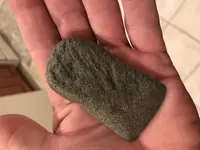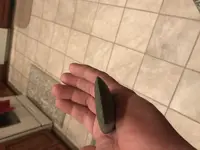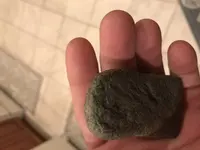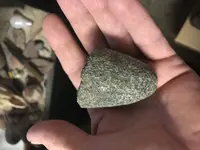canamrider
Jr. Member
I found this out in Central Texas on some family land that only cows have been on for 70 years.
Attachments
Upvote
0
Nope...disagree
You can have an opinion but to let your feathers get so ruffled when fellas respectfully ask for further insight into what you see in a piece to make you believe what you believe is senseless . Many of us post here to help get identification on artifacts and GREATLY appreciate sensible opinions back with knowledge based on experience. Statments like agree to disagree hold no weight. Infact it diminishes your credibility. Especially when you cant swallow your pride when proven wrong by the majority. Take a hike.Nope...disagree
You can have an opinion but to let your feathers get so ruffled when fellas respectfully ask for further insight into what you see in a piece to make you believe what you believe is senseless . Many of us post here to help get identification on artifacts and GREATLY appreciate sensible opinions back with knowledge based on experience. Statments like agree to disagree hold no weight. Infact it diminishes your credibility. Especially when you cant swallow your pride when proven wrong by the majority. Take a hike.
Sent from my SM-G930V using TreasureNet.com mobile app
You can shove your comment too....Like I said earlier, you don't seem to bring much to the table. Go play on Facebook or something.
You can shove your comment too....
Hmmm.
Rock, no offense but I'm not seeing a celt portion any more than I am seeing an ax bit in the start of this thread. Celts were made of a good hard stone as far as I know, not a sandstone.
My heart is broken....I have heard about you trying to start trouble from other people on the site. You sir are going on my block page, later
I have a broken Celt the pole end made of sandstone but as you can see its polished very well. I found it myself in a field. If they ever turn the field again I hope to find the other half.
I guess you need to learn GA Celt materials then. Sandstone comes in many forms from soft to a very hard like this one and yes they used this as a Celt. I guess you learned something again from me.
You can have an opinion but to let your feathers get so ruffled when fellas respectfully ask for further insight into what you see in a piece to make you believe what you believe is senseless . Many of us post here to help get identification on artifacts and GREATLY appreciate sensible opinions back with knowledge based on experience. Statments like agree to disagree hold no weight. Infact it diminishes your credibility. Especially when you cant swallow your pride when proven wrong by the majority. Take a hike.
I agree I think Rock is open to learning his opinion was geofact but if TC saw something he didn't he would like to know what T.C. saw. I have been asked the same question. "Why do you think it's an ......" and like T.C. I took it to offense after thinking about it we are all here to learn and i realized it was a really good question.
I personally spend a lot of time on this forum learning from guy's like Grim, Charl , Rock, Quito and so many others. I have read a lot of T.C 's post's as well I don't believe he intends to cause trouble. Contradicting opinions can be perceived by the poster as disrespect I believe we are all subject to rustled feathers sometime
Interesting. Im not familiar with sandstone back east, but the stuff we have here would definitely crumble if used. And Ive never seen any sandstone artifacts out West here, but that doesnt mean there isnt any. Thank you for that info. I find it really interesting all the different material the natives used for producing tools back then, especially the quartz artifacts and so forth, which you dont seem to find much of out here. I guess quartz can be difficult to work as well, but the Eastern Indians certainly figured it out. Anyway, I dont think that think is artificial.
I guess you need to learn GA Celt materials then. Sandstone comes in many forms from soft to a very hard like this one and yes they used this as a Celt. I guess you learned something again from me.
I guess you need to learn GA Celt materials then. Sandstone comes in many forms from soft to a very hard like this one and yes they used this as a Celt. I guess you learned something again from me.
I will chine in on this one. I spent 15 plus years of my life rock climbing.
Rock is correct,in that there are many different grades of sandstone. Anywhere from ( choss ), sandstone that you can sometimes tear apart with your hands, and very dense sandstone, that when well worn or polished can feel as if it has little or no fine grit.
Likewise limestone can vary tremendously from powdery choss to to a dense form (as for example some of the limestone at the Palisades State Park in Illinois) where some of the rock climbing routes have resulted in some of the stone looking semitransparent, almost quartzite like.[/QUOTE
I just have to say, i understand, believe, and agree that there are many types of sandstone, and limestone. Heck there are variations in most lithics. I also know that many types of tools were fashioned from the sandstone materials.
I just didn't see anything about the form of rocks rock that says, "I am the back portion of a celt", or anything artifact related for that matter. Now if there were a hint or two of beveling indicating a possible bit were there at one time, I'd see things differently.
I will chine in on this one. I spent 15 plus years of my life rock climbing.
Rock is correct,in that there are many different grades of sandstone. Anywhere from ( choss ), sandstone that you can sometimes tear apart with your hands, and very dense sandstone, that when well worn or polished can feel as if it has little or no fine grit.
Likewise limestone can vary tremendously from powdery choss to to a dense form (as for example some of the limestone at the Palisades State Park in Illinois) where some of the rock climbing routes have resulted in some of the stone looking semitransparent, almost quartzite like.[/QUOTE
I just have to say, i understand, believe, and agree that there are many types of sandstone, and limestone. Heck there are variations in most lithics. I also know that many types of tools were fashioned from the sandstone materials.
I just didn't see anything about the form of rocks rock that says, "I am the back portion of a celt", or anything artifact related for that matter. Now if there were a hint or two of beveling indicating a possible bit were there at one time, I'd see things differently.
I believe if you use google image and search "square sided Hopwell celt", you will in fact see examples that have a very similar poll shape to what rock is showing. I actually have no idea if what rock showed is the poll end of a celt, since it could just as well be the poll end of an adz, for instance. Or just a rock, I just don't know. For that matter, I have a pestle with that type of flattened cross section. But, I do know that not all celts taper toward the poll. Based on your earlier observation regarding the shape of polls, I was, in fact, able to find celts with shapes at the poll end similar to rock's rock. Some will have a square shaped poll, but some will have somewhat rounded corners, just like rock's rock, and the celt itself will not taper toward the poll end. Not trying to take sides here, but I know that ne can find celts illustrated on the internet with poll ends similar to rock's....




